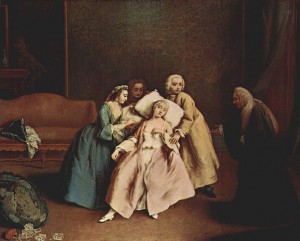A voice called her, but she was gone beyond its reach, for she had sunk senseless upon the ground: it was long before she revived, when she did, she found herself in the arms of a stranger, and made an effort to disengage herself. — Ann Radcliffe, The Romance of the Forest
My wife and I are in the middle of Radcliffe’s The Italian, and just like you can never have a Michael Bay film without lots of explosions, there is no Ann Radcliffe without swooning. I’ve described Udolpho to people as “a great book with a lot of swooning and crying,” and any time I’ve encountered an argument that the book is anti-feminist, it usually centers around constant fainting (in response to shock, horror, or an insensitive comment) as the ultimate depiction of female passivity.
Personally, I think it’s problematic to call Radcliffe’s novels either feminist or anti-feminist… by the standards of her day, the heroines are admirably principled, logical, and empathetic. They have a social and ethical common-sense beyond that of their paramours. Radcliffe’s depiction of gender roles, however, is thoroughly traditional, and the significance of “proper conduct” trumps what most of us would consider more material concerns, like happiness and survival.
Regardless, it is problematic from a Darwinian perspective to have her heroines faint at the drop of a hat. Here someone is compromised and vulnerable — imprisoned, cut off from news and information, harassed by threats and speculation — and she eliminates the little control she maintains by being insensible, dead almost, and literally unable to learn, act, or express herself.
It certainly implies something of the submission-is-power theme, in that the same heroines never waver in their moral resolve, and always triumph in the end. And yet there is nothing intentional about their behavior… they aren’t deciding to swoon.
So I’m not really sure what to make of this occurrence. Is the conspicuous swooning significant to a larger understanding of the Gothic, or is it reflective of a historic attitude that is as impractical as it is sexist? I suspect the answer is both, but I don’t know that I can get more specific than that.

My only knowledge of The Mysteries of Udolpho comes from my reading of Jane Austen’s Northanger Abbey (which basically makes fun of Udolpho and similar novels). Austen was Radcliffe’s contemporary, and from Austen’s attitude towards the Gothic heroine I can only conclude that the conspicuous swooning is significant to an understanding of the Gothic, if only because Austen certainly didn’t share the idea that women would swoon easily.
Hi Flawed,
It’s a good point about the different behavior of heroines between the two writers… although I think Austen would have been the more atypical writer of the two of them.
Also: Northanger Abbey did make fun of Udolpho, but it was a sort of playful parody, not really mocking or scathing. Terry Castle suggested that Austen was inspired by some of Radcliffe’s writing, and she was admired by a whole slew of legitimate Romantic writers. It always bums me when people equate Northanger Abbey with ridicule (I know you are not saying this).
You’re right about Austen though, and it may be one of a few reasons why we see Austen as being so relevant today. Another reason, of course, is that she was one of the best writers in the English language.
Pingback: Gothic Heroines and Natural Selection Part II: Of Corset, Happens! « Connor Coyne
Ha! You know a way to an Austen girl’s heart; I do like Northanger Abbey, but not as much as some of the other novels she wrote. I do want to mention that fainting was not unheard of in Austen’s world; in Sense & Sensibility Marianne had her fits (which were the result of extreme duress, so I find it plausible).
Pingback: Ann Radcliffe’s Italian « Connor Coyne